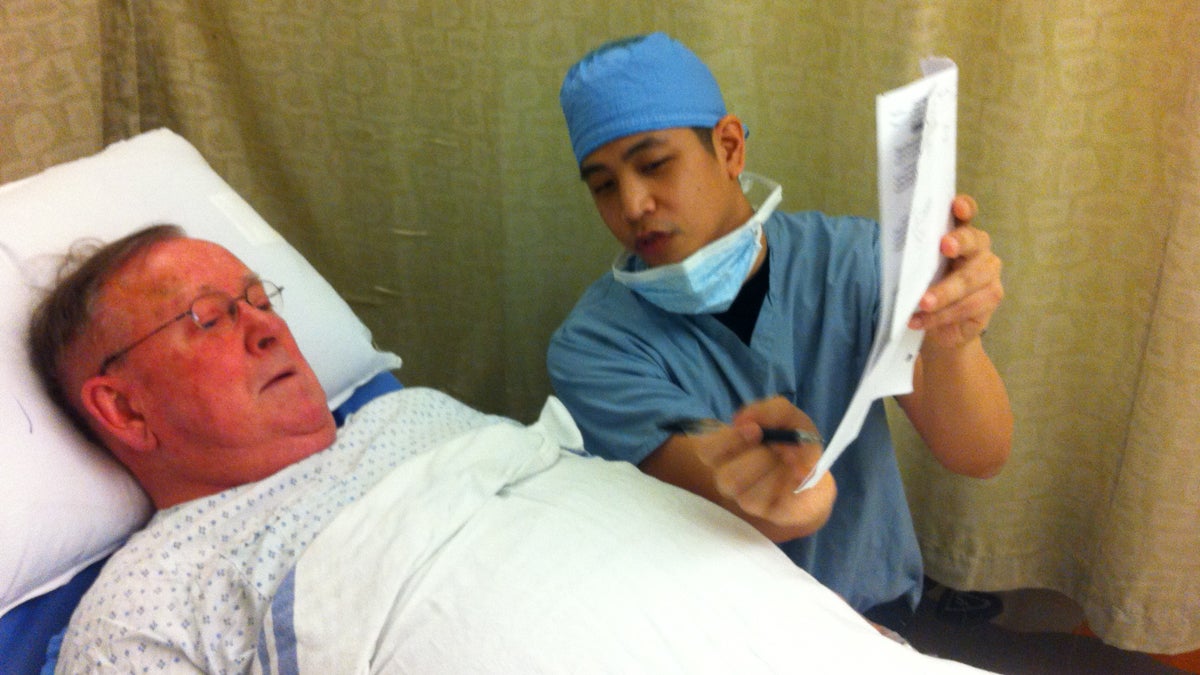Understanding the mechanics of anesthesia
Listen
Anesthesia resident Dr. Arthur Kitt reviews the potential side effects of anesthesia with patient Michael Scanlon. (Maiken Scott/for The Pulse)
Anesthesia drugs are used in millions of patients every year but do doctors really know how they work?
On a recent Monday morning, Catholic priest and Villanova University professor Michael Joseph Scanlon was resting on a hospital bed, answering a series of routine questions before undergoing general anesthesia. U Penn anesthesiologist Max Kelz asked him about possible allergies, other medications, and whether Scanlon had had a problem with anesthesia before. Scanlon said he had no reservations about “going under.”
“The doctor seems very competent, I’m in good hands,” he said.
About an hour later, Scanlon was wheeled into the operating room at the hospital of the University of Pennsylvania, where Kelz hooked him up to an IV, and prepared breathing tubes. “Essentially what we’re doing is becoming the patient’s autonomic nervous system,” Kelz explained. “So we’re going to take over all of the functions that the patient would normally do on his down, such as regulating blood pressure, heart rate, and breathing.” Scanlon received a combination of injectable and breathed-in anesthetic drugs.
“The next thing you’re going to notice is a pleasant feeling coming over you,” said Kelz. Moments later, Scanlon slipped into a deep, sleep-like state.
Routine – safe, but not understood
Anesthesia is a completely routine part of surgeries – but a big, multi-institution research project is dedicated to better understand a very basic question around with process: how anesthetics work.
So – you’re probably thinking right now – hold on, we don’t already know that? Not quite.
“Surprisingly, even though we use anesthesia drugs with 250 million patients every year worldwide, and have been using it since 1850, we don’t know how they work,” explained Roderick Eckenhoff, a professor of anesthesiology at the University of Pennsylvania. “We don’t know which molecular targets they engage, how they are altered, to produce what is really, a miracle; patients go to sleep, they don’t remember things, they don’t feel things, and most importantly, they wake up.”
Eckenhoff is working on a major, ongoing research project that brings together scientists from different disciplines – anesthesia, biology, chemistry – to better understand the mechanics of anesthesia. He says they could be looking for several, perhaps dozens of different molecular targets, each responsible for a different effect of the anesthesia drug, and its side effects.
Eckenhoff said that one of the goals of this research is to reduce the side effects of anesthesia.
“There is a concern that these drugs could have a durable cognitive effect, that they might not leave the brain entirely unchanged,” he explained. “If a patient has a preexisting vulnerability in their brain, such as Alzheimer’s disease, these drugs could interact with that process as to accelerate it,” he said.
Nausea after anesthesia is another major concern, and a side effect that is not well understood. “It’s very serious,” said Eckenhoff, “many patients tell us they would rather have pain than be nauseated, we’re trying to figure out how to get rid of this.”
Eckenhoff says another area of interest is the impact of anesthesia on the cardiac and respiratory systems. This is especially important with trauma patients. “These drugs can tip somebody over the edge who is already close to the edge – we’d like to identify the basis for these side effects and see if we can modulate them.”
Basically, said Eckenhoff, the goal is to get the effects of anesthesia, without all of the “baggage that comes with it.”
WHYY is your source for fact-based, in-depth journalism and information. As a nonprofit organization, we rely on financial support from readers like you. Please give today.




